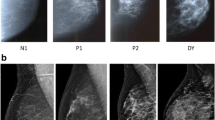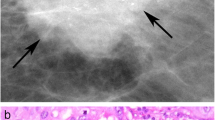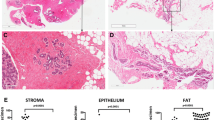Abstract
Background Mammographic density is the third largest risk factor for ductal carcinoma in-situ (DCIS) and invasive breast cancer. However, the question of whether risk-mediating precursor histological changes, such as columnar cell lesions (CCLs), can be found in dense but non-malignant breast tissues has not been systematically addressed. We hypothesized that CCLs may be related to breast composition, in particular breast density, in non-tumour containing breast tissue. Patients and methods We examined randomly selected tissue samples obtained by bilateral subcutaneous mastectomy from a forensic autopsy series, where tissue composition was assessed, and in which there had been no selection of subjects or histological specimens for breast disease. We reviewed H&E slides for the presence of atypical and non-atypical CCLs and correlated with histological features measured using quantitative microscopy. Results CCLs were seen in 40 out of 236 cases (17%). The presence of CCLs was found to be associated with several measures of breast tissue composition, including radiographic density: high Faxitron Wolfe Density (P = 0.037), high density estimated by percentage non-adipose tissue area (P = 0.037), high percentage collagen (P = 9.2E−05) and high percentage glandular area (P = 2E−05). DCIS was identified in two atypical CCL cases. The extent of CCL was not associated with any of the examined variables. Conclusion Our study is the first to report a possible association between CCLs and breast tissue composition, including mammographic density. Our data suggest that prospective elucidation of the strength and nature of the clinicopathological correlation may lead to an enhanced understanding of mammographic density and evidence based management strategies.



Similar content being viewed by others
Abbreviations
- ADH:
-
Atypical ductal hyperplasia
- ALH:
-
Atypical lobular hyperplasia
- BMI:
-
Body mass index
- CCC:
-
Columnar cell change
- CCH:
-
Columnar cell hyperplasia
- CCL:
-
Columnar cell lesion
- DCIS:
-
Ductal carcinoma in-situ
- DIN1a, DIN1b:
-
Ductal intraepithelial neoplasia 1b, 1a
- ER:
-
Estrogen receptor
- MD:
-
Mammographic density
- TDLU:
-
Terminal duct lobular unit
- UDH:
-
Usual ductal hyperplasia
References
Ingleby H, Gerson-Cohen J (1960) Comparative anatomy, pathology and roentgenology of the breast. University of Philadelphia Press, Philadelphia
Li T, Sun L, Miller N et al (2005) The association of measured breast tissue characteristics with mammographic density and other risk factors for breast cancer. Cancer Epidemiol Biomarkers Prev 14:343–349. doi:10.1158/1055-9965.EPI-04-0490
Boyd NF, Dite GS, Stone J et al (2002) Heritability of mammographic density, a risk factor for breast cancer. N Engl J Med 347:886–894. doi:10.1056/NEJMoa013390
von Schoultz B (2004) The effects of tibolone and oestrogen-based HT on breast cell proliferation and mammographic density. Maturitas 49:S16–S21. doi:10.1016/j.maturitas.2004.06.011
Topal NB, Ayhan S, Topal U et al (2006) Effects of hormone replacement therapy regimens on mammographic breast density: the role of progestins. J Obstet Gynaecol Res 32:305–308. doi:10.1111/j.1447-0756.2006.00402.x
van Gils CH, Hendriks JH, Otten JD et al (2000) Parity and mammographic breast density in relation to breast cancer risk: indication of interaction. Eur J Cancer Prev 9:105–111. doi:10.1097/00008469-200004000-00006
Boyd NF, Lockwood GA, Byng JW et al (1998) Mammographic densities and breast cancer risk. Cancer Epidemiol Biomarkers Prev 7:1133–1144
Arthur JE, Ellis IO, Flowers C et al (1990) The relationship of “high risk” mammographic patterns to histological risk factors for development of cancer in the human breast. Br J Radiol 63:845–849
Urbanski S, Jensen HM, Cooke G et al (1988) The association of histological and radiological indicators of breast cancer risk. Br J Cancer 58:474–479
Foote FW, Stewart FW (1945) Comparative studies of cancerous versus noncancerous breasts. Ann Surg 121:197–222
Lanyi M, Citoler P (1981) The differential diagnosis of microcalcification. Micro-cyst (blunt duct) adenosis (author’s transl). Rofo 134:225–231
Azzopardi JG, Ahmed A, Millis RR (1979) Problems in breast pathology. Major Probl Pathol 11:i–xvi, 1–466
Tavassoli FA (2001) Ductal intraepithelial neoplasia of the breast. Virchows Arch 438:221–227. doi:10.1007/s004280100394
Eusebi V, Foschini MP, Cook MG et al (1989) Long-term follow-up of in situ carcinoma of the breast with special emphasis on clinging carcinoma. Semin Diagn Pathol 6:165–173
WHO (2003) World health organization classification of tumours. Pathology and genetics of tumours of the breast and female genital organs. IARC Press, Lyon, France
Rosen PP (2001) Rosen’s breast pathology. Lippincott Williams & Wilkins, Philadelphia
McLaren BK, Gobbi H, Schuyler PA et al (2005) Immunohistochemical expression of estrogen receptor in enlarged lobular units with columnar alteration in benign breast biopsies: a nested case-control study. Am J Surg Pathol 29:105–108. doi:10.1097/01.pas.0000146013.76881.d9
Luna-More S, Weil B, Bautista D et al (2004) Bcl-2 protein in normal, hyperplastic and neoplastic breast tissues. A metabolite of the putative stem-cell subpopulation of the mammary gland. Histol Histopathol 19:457–463
Goldstein NS, O’Malley BA (1997) Cancerization of small ectatic ducts of the breast by ductal carcinoma in situ cells with apocrine snouts: a lesion associated with tubular carcinoma. Am J Clin Pathol 107:561–566
Gopalan A, Hoda SA (2005) Columnar cell hyperplasia and lobular carcinoma in situ coexisting in the same duct. Breast J 11:210. doi:10.1111/j.1075-122X.2005.21459.x
Rosen PP (1999) Columnar cell hyperplasia is associated with lobular carcinoma in situ and tubular carcinoma. Am J Surg Pathol 23:1561. doi:10.1097/00000478-199912000-00017
Sahoo S, Recant WM (2005) Triad of columnar cell alteration, lobular carcinoma in situ, and tubular carcinoma of the breast. Breast J 11:140–142. doi:10.1111/j.1075-122X.2005.21616.x
Simpson PT, Gale T, Reis-Filho JS et al (2005) Columnar cell lesions of the breast: the missing link in breast cancer progression? A morphological and molecular analysis. Am J Surg Pathol 29:734–746. doi:10.1097/01.pas.0000157295.93914.3b
Sewell CW (2004) Pathology of high-risk breast lesions and ductal carcinoma in situ. Radiol Clin North Am 42:821–830. doi:10.1016/j.rcl.2004.03.013
Feeley L, Quinn CM (2008) Columnar cell lesions of the breast. Histopathology 52:11–19
Pinder SE, Reis-Filho JS (2007) Non-operative breast pathology: columnar cell lesions. J Clin Pathol 60:1307–1312. doi:10.1136/jcp.2006.040634
Kim MJ, Kim EK, Oh KK et al (2006) Columnar cell lesions of the breast: mammographic and US features. Eur J Radiol 60:264–269. doi:10.1016/j.ejrad.2006.06.013
Bartow SA, Mettler RT, Black WC (1997) Correlations between radiographic patterns and morphology of the female breast. Rad Patterns Morphol 13:263–275
Hart BL, Steinbock RT, Mettler FA Jr et al (1989) Age and race related changes in mammographic parenchymal patterns. Cancer 63:2537–2539. doi :10.1002/1097-0142(19890615)63:12<2537::AID-CNCR2820631230>3.0.CO;2-0
Bartow SA, Pathak DR, Mettler FA et al (1995) Breast mammographic pattern: a concatenation of confounding and breast cancer risk factors. Am J Epidemiol 142:813–819
Bartow SA, Pathak DR, Black WC et al (1987) Prevalence of benign, atypical, and malignant breast lesions in populations at different risk for breast cancer. A forensic autopsy study. Cancer 60:2751–2760. doi :10.1002/1097-0142(19871201)60:11<2751::AID-CNCR2820601127>3.0.CO;2-M
Schnitt SJ, Vincent-Salomon A (2003) Columnar cell lesions of the breast. Adv Anat Pathol 10:113–124. doi:10.1097/00125480-200305000-00001
Boyd NF, Martin LJ, Yaffe MJ et al (2006) Mammographic density: a hormonally responsive risk factor for breast cancer. J Br Menopause Soc 12:186–193. doi:10.1258/136218006779160436
Boyd NF, Guo H, Martin LJ et al (2007) Mammographic density and the risk and detection of breast cancer. N Engl J Med 356:227–236. doi:10.1056/NEJMoa062790
Mitchell G, Antoniou AC, Warren R et al (2006) Mammographic density and breast cancer risk in BRCA1 and BRCA2 mutation carriers. Cancer Res 66:1866–1872. doi:10.1158/0008-5472.CAN-05-3368
Falkenberry SS, Legare RD (2002) Risk factors for breast cancer. Obstet Gynecol Clin North Am 29:159–172. doi:10.1016/S0889-8545(03)00059-7
Hulka BS, Moorman PG (2001) Breast cancer: hormones and other risk factors. Maturitas 38:103–113. discussion 113–106. doi:10.1016/S0378-5122(00)00196-1
Martin AM, Weber BL (2000) Genetic and hormonal risk factors in breast cancer. J Natl Cancer Inst 92:1126–1135. doi:10.1093/jnci/92.14.1126
Laden F, Hunter DJ (1998) Environmental risk factors and female breast cancer. Annu Rev Public Health 19:101–123. doi:10.1146/annurev.publhealth.19.1.101
Bartow SA, Pathak DR, Mettler FA (1990) Radiographic microcalcification and parenchymal patterns as indicators of histologic “high-risk” benign breast disease. Cancer 66:1721–1725. doi :10.1002/1097-0142(19901015)66:8<1721::AID-CNCR2820660812>3.0.CO;2-I
Wellings SR, Wolfe JN (1978) Correlative studies of the histological and radiographic appearance of the breast parenchyma. Radiology 129:299–306
Bright RA, Morrison AS, Brisson J et al (1988) Relationship between mammographic and histologic features of breast tissue in women with benign biopsies. Cancer 61:266–271. doi :10.1002/1097-0142(19880115)61:2<266::AID-CNCR2820610212>3.0.CO;2-N
Bland KI, Kuhns JG, Buchanan JB et al (1982) A clinicopathologic correlation of mammographic parenchymal patterns and associated risk factors for human mammary carcinoma. Ann Surg 195:582–594. doi:10.1097/00000658-198205000-00007
Boyd NF, Jensen HM, Cooke G et al (1992) Relationship between mammographic and histological risk factors for breast cancer. J Natl Cancer Inst 84:1170–1179. doi:10.1093/jnci/84.15.1170
Boyd NF, Jensen HM, Cooke G et al (2000) Mammographic densities and the prevalence and incidence of histological types of benign breast disease. Reference pathologists of the canadian national breast screening study. Eur J Cancer Prev 9:15–24. doi:10.1097/00008469-200002000-00003
Key TJ, Verkasalo PK, Banks E (2001) Epidemiology of breast cancer. Lancet Oncol 2:133–140. doi:10.1016/S1470-2045(00)00254-0
Russo J, Hu YF, Yang X (2000) Developmental, cellular, and molecular basis of human breast cancer. J Natl Cancer Inst Monogr 27:17–37
Butler LM, Potischman NA, Newman B (2000) Menstrual risk factors and early-onset breast cancer. Cancer Causes Control 11:451–458. doi:10.1023/A:1008956524669
Bissell MJ, Barcellos-Hoff MH (1987) The influence of extracellular matrix on gene expression: is structure the message? J Cell Sci Suppl 8:327–343
Tlsty TD (1998) Cell-adhesion-dependent influences on genomic instability and carcinogenesis. Curr Opin Cell Biol 10:647–653. doi:10.1016/S0955-0674(98)80041-0
Guo YP, Martin LJ, Hanna W et al (2001) Growth factors and stromal matrix proteins associated with mammographic densities. Cancer Epidemiol Biomarkers Prev 10:243–248
Boyd NF, Stone J, Martin LJ et al (2002) The association of breast mitogens with mammographic densities. Br J Cancer 87:876–882. doi:10.1038/sj.bjc.6600537
Hankinson SE, Willett WC, Michaud DS (1999) Plasma prolactin levels and subsequent risk of breast cancer in postmenopausal women. J Natl Cancer Inst 91:629–634. doi:10.1093/jnci/91.7.629
Hankinson SE, Willett WC, Colditz GA et al (1998) Circulating concentrations of insulin-like growth factor-I and risk of breast cancer. Lancet 351:1393–1396. doi:10.1016/S0140-6736(97)10384-1
Acknowledgments
We thank the generous assistance of Dr. Sue Bartow in providing access to the material on which this study was based. S. Aparicio is supported by Canada Research Chair in Molecular Oncology. G. Turashvili is supported by the CIHR Training Program for Clinician Scientists in Molecular Oncologic Pathology (STP-53912).
Author information
Authors and Affiliations
Corresponding author
Electronic supplementary material
Rights and permissions
About this article
Cite this article
Turashvili, G., McKinney, S., Martin, L. et al. Columnar cell lesions, mammographic density and breast cancer risk. Breast Cancer Res Treat 115, 561–571 (2009). https://doi.org/10.1007/s10549-008-0099-x
Received:
Accepted:
Published:
Issue Date:
DOI: https://doi.org/10.1007/s10549-008-0099-x




